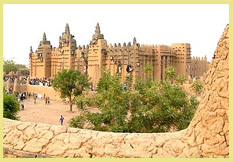




Rock-art & Pre-history

Evidence of early human artistic expression in Africa commonly takes the form of rock paintings and engravings. Some of these are thought to date back 12,000 years, but most are much more recent. They are found across the continent, with the best preserved sites found in the Sahara and the deserts of southern Africa. In many areas they trace a rich history, providing evidence of environmental change, or recording significant events, such as the introduction of horses and chariots to parts of the Sahara. Rock art depicts animals, such as elephants, hippos and giraffes that once occurred in the interior of the Sahara but became extinct as the rich savanna ecosystem turned to desert. Across the continent, rock-art subjects include highly revered animals and important aspects of local culture and lifestyle, particularly hunting scenes. Abstract symbols are also widespread, but much more difficult to interpret.
Four of the seven ‘prime’ rock-art sites are in desert areas, notably the mountain ranges of southern Algeria (Tassili n’Ajjer) and neighbouring parts of Libya (Tadrart Acacus). In southern Africa, rock-art in the Namib Desert is best represented by the exposed engravings at Twyfelfontein, and the paintings on the cliffs and rock shelters of the Tsodilo Hills on the fringes of the Kalahari Desert in north-western Botswana. Elsewhere on the continent, rock-art has survived best in caves, rock shelters and overhangs, where it has been protected from the worst effects of weathering. There seems to be a concentration of such sites in eastern and southern Africa, where granite hills and outcrops have been occupied by people, providing ideal conditions for the development of such art. Sites in these wetter parts of the continent include (from north to south) Kondoa in Tanzania, Chongoni in Malawi, the Matobo Hills in Zimbabwe, and the Drakensberg of South Africa. The paintings in these places are thought to be more recent than those in the deserts, with some little more than a century or two old. Rock-art discoveries in sub-Saharan West Africa are comparatively rare (perhaps because of a shortage of suitable rocky areas?) but there is a concentration of intriguing ancient rock engravings on exposed rocks in the Lope-Okanda landscape, and rock art is still an important part of Dogon culture at the Cliffs of Bandiagara in Mali.
Other aspects of human pre-history in Africa are represented by the collection of Stone Circles that mark burial sites across a wide area north of the Gambia River in West Africa, and by the engraved rock stelae of Tiya in Ethiopia. The age of these ancient monoliths remains a mystery, as does their cultural meaning and the broader context in which the people responsible for them developed.
PLEASE HELP SAVE THE THREATENED ROCK ART OF THE SAHARA! TARA, the Trust for African Rock Art, is based in Nairobi, Kenya and is committed to recording Africa's rich rock art heritage. TARA's aim is to make this information widely available and accessible and, to the extent possible, preserve today's most threatened sites, however remote, across the African continent. TARA aims to raise $60,000 over 45 days (18th May to 1st July 2015) for urgent work on the Sahara's endangered rock art. Please donate what you can by clicking here.
Other key places: There are many other important rock-art sites across the continent and there is a need for a detailed comparative study to determine which of these is of greatest importance in terms of concentration, quality and state of preservation. There may well be other sites that would warrant world heritage status.
To read more about each of the world heritage sites featuring rock-art and human pre-history, and see a slideshow of each place, follow these links:




.jpg)